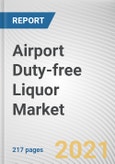Airport duty-free liquor refers to the liquor available at airport and is exempted from payment of national taxes, duties, and other certain local taxes. The airport duty-free liquor is purchased by the travelers, travelling from one country to another through flight. The rules and regulations on airport duty-free liquor differ from one country to another. Singapore has strict government rules on the purchase of duty-free liquor whereas India allows the passenger to purchase two to three liters of alcohol from airport duty-free shops.
The growth of the global airport duty-free liquor is majorly driven by development of the travel & tourism industry. The rise in tourism promotion, increase in number of passengers and frequent fliers, and others, are expected to fuel the growth of the airport duty-free liquor market. Also, increase in disposable income of individuals, particularly in Europe and Asia-Pacific, is anticipated to witness high growth, thus driving the overall growth of the market However, stringent government rules, especially for airport retailing, are expected to hamper the market growth. This is due the strict baggage rules for air travel passengers that limit the baggage capacity or charge extra for excess baggage.
The outbreak of the COVID-19 pandemic has adversely affected the growth of the duty-free liquor market. People are restricted to stay at their homes to stop the spread of the diseases. Governments have been forced to introduce and maintain social and mobility restrictions in an attempt to control spread of the disease. In this context, the shops of airport duty-free liquor have been closed. As the travel retail sector market is temporarily on hold, airport duty-free liquor has experienced crucial sales channel cutoff. Many international flights have been cancelled during the lockdown period, which is expected to halt growth of the airport duty-free liquor market.
The global airport duty-free liquor market is segmented on the basis of type into whiskey and others.
The report highlights the drivers, restraints, opportunities, and growth strategies adopted by the
KEY PLAYERS
to understand the dynamics and potential of the industry. Key players operating in the airport duty-free liquor market are profiled to provide a competitive landscape of the marketspace.The major players profiled in the report are Brown-Forman, Diageo, Erdington, Bacardi, Heineken, Glen Moray, Accolade Wines, Constellation Brands, Inc., REMY COINTREAU, Pernod, Ricard.
Key Benefits for Stakeholders
- The report includes an in-depth analysis of different segments and provides market estimations between 2021 and 2027.
- Porter’s five forces model illustrates the potency of buyers & sellers, which assists the market players to adopt effective strategies.
- Key market players are profiled to gain an understanding of the strategies adopted by them.
- This report provides a detailed analysis of the current trends and future estimations from 2021 to 2027, which helps identify the prevailing market opportunities.
KEY SEGMENTS
By Type
- Whiskey
- Other
By Region
- North America
- U.S.
- Canada
- Europe
- UK
- France
- Italy
- Spain
- Germany
- The Netherland
- Denmark
- Russia
- Switzerland
- Ireland
- Sweden
- Asia-Pacific
- Japan
- Korea
- China
- Taiwan
- Hong Kong
- Singapore
- Thailand
- Indonesia
- Malaysia
- UAE
- Qatar
- Oceania
- Australia
- New Zealand
Please note:
- Online Access price format is valid for 60 days access. Printing is not enabled.
- PDF Single and Enterprise price formats enable printing.
Table of Contents
Methodology
The analyst offers exhaustive research and analysis based on a wide variety of factual inputs, which largely include interviews with industry participants, reliable statistics, and regional intelligence. The in-house industry experts play an instrumental role in designing analytic tools and models, tailored to the requirements of a particular industry segment. The primary research efforts include reaching out participants through mail, tele-conversations, referrals, professional networks, and face-to-face interactions.
They are also in professional corporate relations with various companies that allow them greater flexibility for reaching out to industry participants and commentators for interviews and discussions.
They also refer to a broad array of industry sources for their secondary research, which typically include; however, not limited to:
- Company SEC filings, annual reports, company websites, broker & financial reports, and investor presentations for competitive scenario and shape of the industry
- Scientific and technical writings for product information and related preemptions
- Regional government and statistical databases for macro analysis
- Authentic news articles and other related releases for market evaluation
- Internal and external proprietary databases, key market indicators, and relevant press releases for market estimates and forecast
Furthermore, the accuracy of the data will be analyzed and validated by conducting additional primaries with various industry experts and KOLs. They also provide robust post-sales support to clients.

LOADING...








